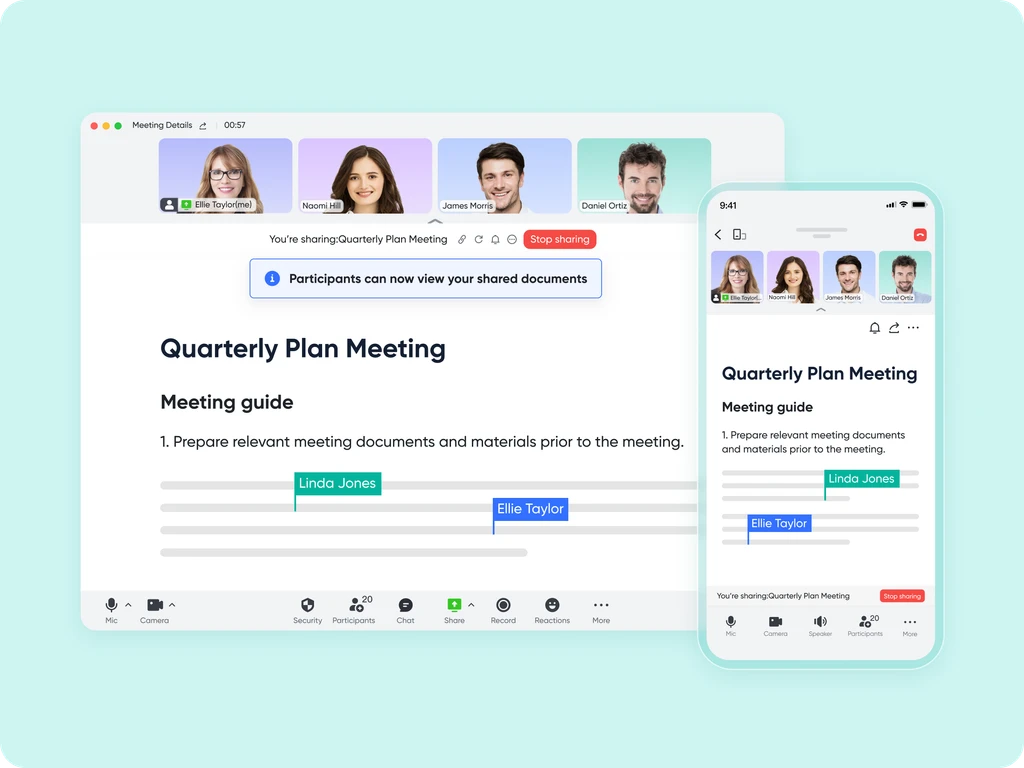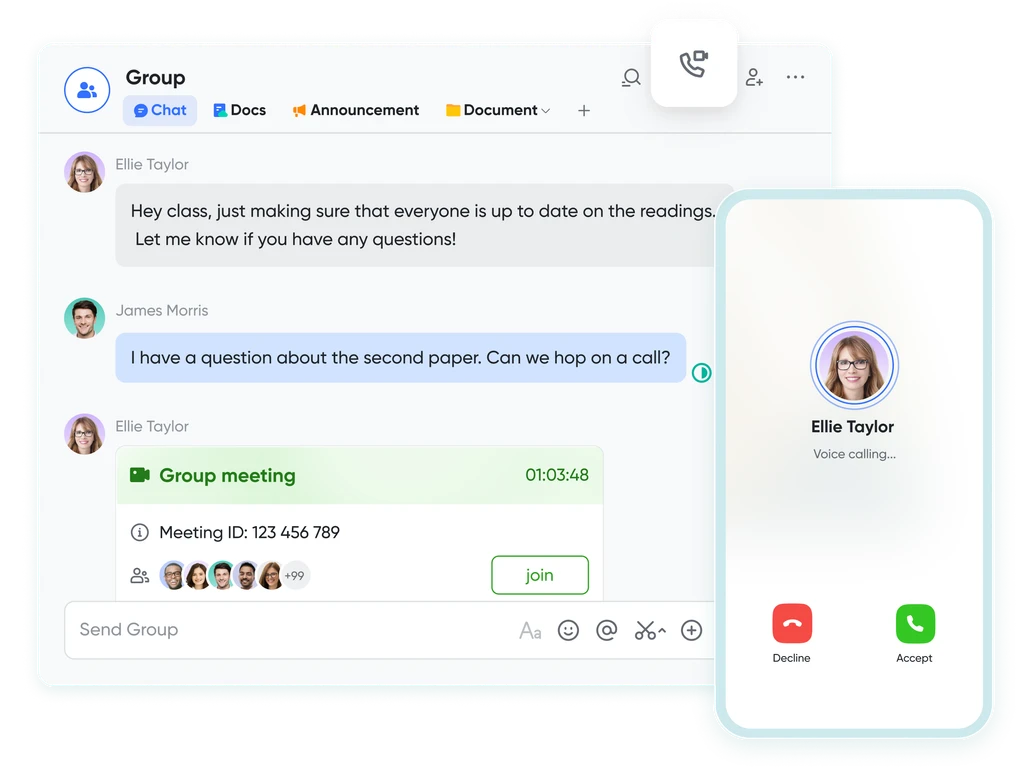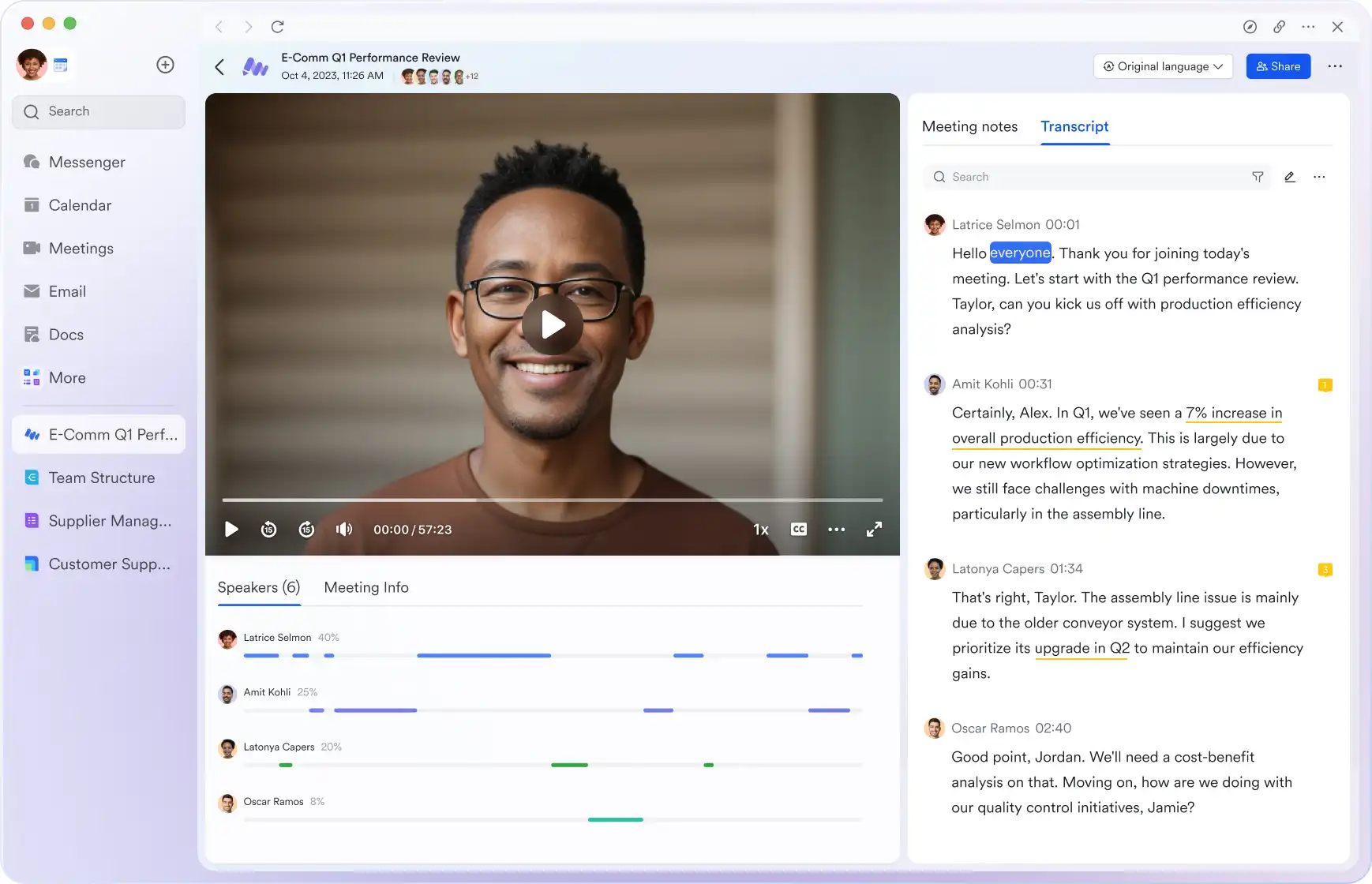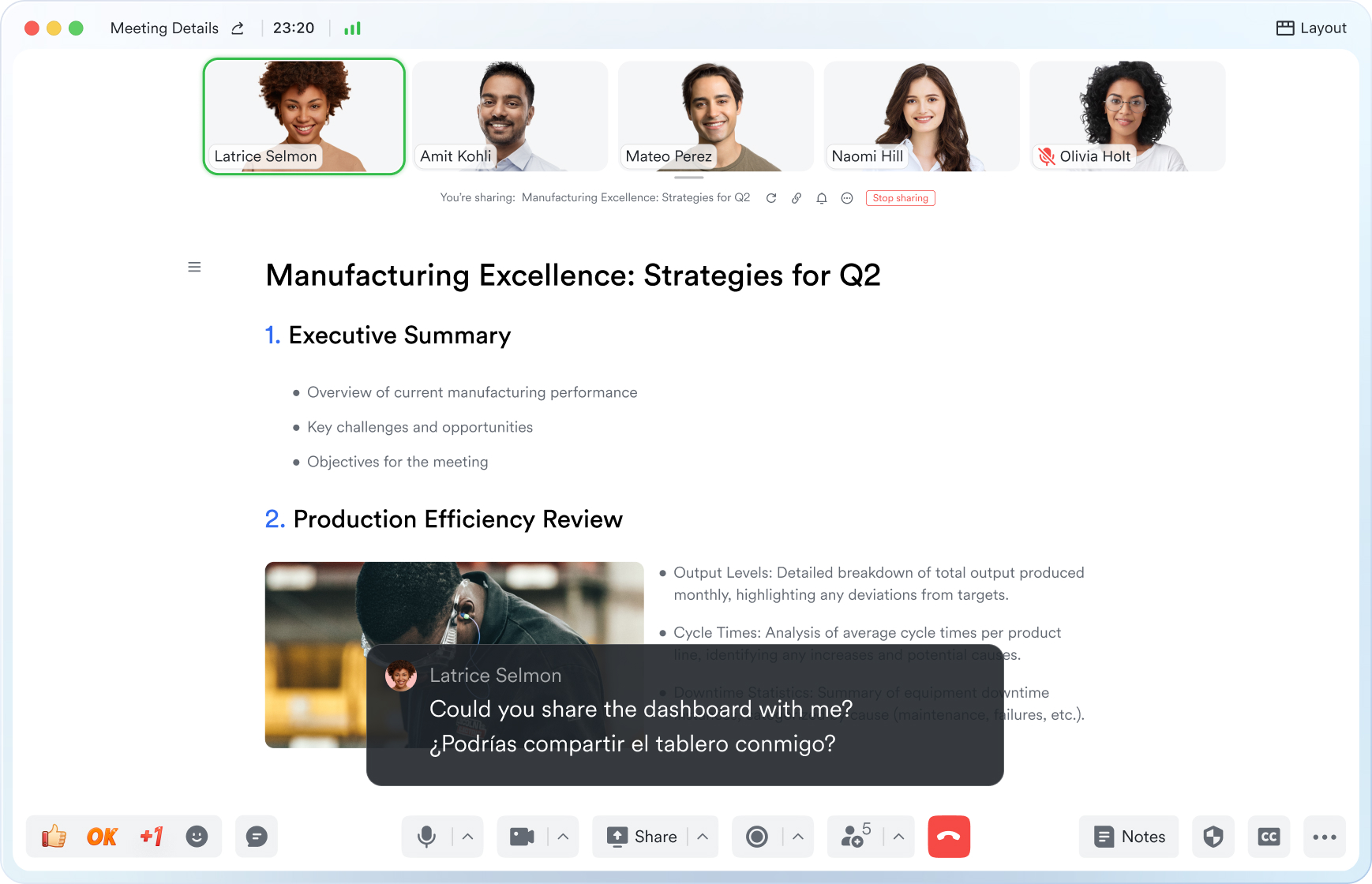Decision Making Meeting
This guide will walk you through the essential elements of use decision making meeting to keep your attendees aligned and engaged.
Try Lark for Free
Decision-making meetings are pivotal moments in any organization's operations, where leaders and teams come together to analyze information, evaluate options, and make critical choices. These meetings serve as the foundation for effective decision-making processes, impacting the future direction and success of projects, initiatives, and the overall business. In this comprehensive guide, we'll explore the significance of decision-making meetings, how to conduct them effectively, and best practices for making informed and strategic decisions.
Use Lark Meetings to turn meetings into true collaborative experiences.
What is a decision-making meeting?
Unraveling the Essence
A decision-making meeting is a focused gathering of individuals or teams convened with the primary objective of reaching consensus or making informed decisions on specific matters. These meetings are characterized by their structured approach to evaluating options, considering implications, and choosing the most suitable course of action.
Goals of decision-making meetings
Achieving Clarity and Alignment
The primary goals of decision-making meetings include:
- Clarity: Gaining a clear understanding of the issues or choices at hand.
- Alignment: Ensuring that participants are on the same page regarding objectives and decisions.
- Informed Choices: Making well-informed decisions backed by data, analysis, and thoughtful consideration.
- Action Planning: Defining actionable steps, responsibilities, and timelines for implementation.
Who should attend decision-making meetings?
Key Participants
Decision-making meetings may involve a range of participants depending on the nature and scope of the decision. Key participants often include:
- Decision-Makers: Individuals or teams responsible for making the final choice.
- Subject-Matter Experts: Individuals with relevant expertise or knowledge related to the decision.
- Stakeholders: Individuals or teams directly affected by the decision or with a vested interest in the outcome.
Related:
Unlock the Power of Webinars: A Comprehensive Guide to Boost Your Business | Lark Blog | Lark BlogLearn more about Lark x Meetings
Topics, agenda, and structure of decision-making meetings
Structuring the Meeting
A well-structured decision-making meeting typically follows a defined agenda and may include the following components:
- Preparation: Reviewing relevant information, data, and analysis prior to the meeting.
- Introduction: Setting the meeting's purpose, objectives, and ground rules.
- Problem Statement: Clearly defining the issue or decision to be addressed.
- Data Presentation: Presenting relevant information, facts, and analysis.
- Discussion: Encouraging open dialogue, questions, and clarifications.
- Option Evaluation: Exploring various options, their pros and cons, and potential outcomes.
- Decision-Making Process: Identifying decision criteria, preferences, and voting mechanisms.
- Consensus Building: Seeking alignment and agreement among participants.
- Action Planning: Defining next steps, responsibilities, and timelines.
- Conclusion: Summarizing the decision and closing the meeting.
How to conduct an effective decision-making meeting?
Step-by-Step Guide
Conducting an effective decision-making meeting requires a strategic approach. Follow these steps for successful decision-making meetings:
- Preparation: Collect and distribute relevant information and data to participants in advance.
- Agenda Creation: Develop a clear and structured agenda with time allocations for each component.
- Facilitation: Appoint a skilled facilitator to guide the meeting, maintain focus, and manage discussions.
- Data Presentation: Present data, analysis, and insights in a concise and understandable manner.
- Open Dialogue: Encourage open dialogue, questions, and discussions among participants.
- Option Exploration: Explore various options, considering their advantages and disadvantages.
- Decision Criteria: Define criteria and factors that will be used to evaluate options.
- Voting or Consensus: Determine the decision-making process, whether it involves voting, consensus-building, or other methods.
- Record Keeping: Document key decisions, action items, and responsibilities during the meeting.
- Follow-Up: Ensure that action items are communicated and tracked post-meeting, and provide updates as necessary.
Learn more about Lark x Meetings
How often should you hold decision-making meetings?
Meeting Frequency
The frequency of decision-making meetings varies depending on the organization's needs and the complexity of decisions. Some decisions may require frequent meetings, while others may occur on an ad-hoc basis as specific issues arise. The key is to schedule decision-making meetings when they are necessary to make informed choices.
Key differences between decision-making meetings and similar meetings
Understanding Distinctions
Decision-making meetings have unique characteristics that distinguish them from other types of meetings:
- Focus on Choices: These meetings are primarily centered around evaluating options and making choices.
- Structured Approach: Decision-making meetings follow a structured agenda and process.
- Outcome-Oriented: The ultimate goal is to reach a clear decision and define next steps.
Related:
Master the Art of Meeting Notes with Lark for Enhanced Collaboration | Lark Blog | Lark BlogLearn more about Lark x Meetings
Common pitfalls of decision-making meetings
Avoiding Mistakes
To ensure the success of decision-making meetings, be cautious of these common pitfalls:
- Lack of Preparation: Not providing participants with sufficient information and data in advance.
- Overly Dominant Voices: Allowing one or a few individuals to dominate discussions, potentially sidelining valuable input.
- Rushed Decisions: Not allocating adequate time for discussions, leading to rushed decisions.
- Inadequate Documentation: Failing to document decisions, action items, and responsibilities.
Tips for maximizing the impact of decision-making meetings
Enhancing Effectiveness
To maximize the impact of decision-making meetings, consider implementing these tips:
- Thorough Preparation: Ensure all participants are well-prepared with the necessary information.
- Inclusive Discussions: Encourage participation from all relevant stakeholders and seek diverse perspectives.
- Structured Process: Follow a structured agenda and decision-making process to maintain focus.
- Clear Documentation: Document key decisions, action items, and responsibilities during and after the meeting.
Learn more about Lark x Meetings
Examples
Real-world scenarios
Real-world scenarios
Let's explore three real-world scenarios of effective decision-making meetings in different contexts:
Scenario 1: Project Investment Decision Meeting
Brief Content: A technology company convenes a decision-making meeting to evaluate two potential projects for investment. The meeting is attended by senior executives, project managers, and financial analysts.
Detailed Content: The decision-making meeting begins with a comprehensive presentation of both project proposals, including their objectives, expected returns, and risks. Participants engage in a structured discussion, raising questions and concerns related to each project. The meeting explores decision criteria, such as financial viability, strategic alignment, and resource availability. After thorough deliberation and voting, the participants reach a consensus to proceed with one of the projects, based on its potential for high returns and strategic significance. The meeting concludes with a clear decision, action items for project initiation, and a timeline for implementation.
Scenario 2: Product Development Direction Meeting
Brief Content: A product development team holds a decision-making meeting to determine the direction of an upcoming product release. The meeting includes product managers, designers, and developers.
Detailed Content: The decision-making meeting commences with an overview of the product
's current status, market research findings, and competitor analysis. Participants engage in a lively discussion, sharing their insights on potential features, user experience enhancements, and market positioning. The meeting employs a structured decision-making process, where each proposed direction is evaluated against predefined criteria, including customer demand, technical feasibility, and alignment with the company's strategic goals. After thorough deliberation and consensus-building, the team agrees on the direction that maximizes customer value and competitive advantage. The meeting concludes with a clear decision, an action plan for development, and assigned responsibilities.
Scenario 3: Crisis Response Decision Meeting
Brief Content: An organization faces a sudden crisis, and its leadership team convenes an emergency decision-making meeting to respond effectively. The meeting involves top executives, legal counsel, and crisis management experts.
Detailed Content: The decision-making meeting begins with a concise briefing on the crisis situation, including its nature, potential impacts, and legal implications. Participants engage in focused discussions, exploring various response strategies, communication plans, and risk mitigation measures. The meeting adheres to a structured decision-making process that involves identifying priorities, assessing risks, and aligning actions with the organization's values and reputation. After thorough deliberation and unanimous agreement, the leadership team decides on a crisis response plan that emphasizes transparency, accountability, and stakeholder communication. The meeting concludes with a clearly defined crisis response strategy, immediate action items, and a timeline for implementation.
Tips for do's and don'ts
Best Practices and Pitfalls to Avoid
Follow these do's and don'ts to ensure productive and effective decision-making meetings:
| Do's | Don'ts |
|---|---|
| Provide participants with relevant information and data in advance. | Don't allow participants to attend the meeting without adequate preparation. |
| Encourage diverse perspectives and active participation from all relevant stakeholders. | Avoid sidelining valuable input or dominating discussions. |
| Follow a structured agenda and decision-making process to maintain focus. | Don't rush through discussions or make hasty decisions without thorough analysis. |
| Document key decisions, action items, and responsibilities during and after the meeting. | Neglect to communicate decisions and follow up on action items in a timely manner. |
Use Lark Meetings to turn meetings into true collaborative experiences.
A Game Changer for Decision Making Meeting: Empower your team with Lark Meetings
In the fast-paced and dynamic world of modern business, effective communication and collaboration are crucial for success of Decision Making Meeting. Here we introduce Lark Meetings to serve as a centralized hub for all communication needs.
Transform your meetings into collaborative endeavors

Leverage the potency of in-call document sharing, intelligent meeting minutes, and mobile-optimized features to enhance productivity collaboratively, irrespective of your location or schedule.
Seamlessly collaborate in real-time, across any device

Share live documents instead of just screen views. Participants can navigate and edit simultaneously within the video call window, even while on the move.
Shift your focus to engagement, not note-taking

Lark Minutes automatically converts video meetings into transcripts, facilitating easy viewing, searching, and collaborative editing. Stay in the loop asynchronously, even if you can't attend the live meeting. Lark Minutes for meeting minutes support translation into 10+ different languages.
Break language barriers in communication

Lark Meetings provide real-time translation for subtitles, allowing individuals from diverse backgrounds to express themselves in their native languages. Ensure every voice is heard, regardless of geographical location. Live subtitles currently support translations from English, Chinese, and Japanese to 10+ different languages. See more translation feature in Lark.
Connect with larger audiences
Host dynamic online meetings and events accommodating up to 1,000 participants, with the flexibility of up to 50 breakout sessions for intimate group discussions within the larger meeting context. Try more Lark features for free.








